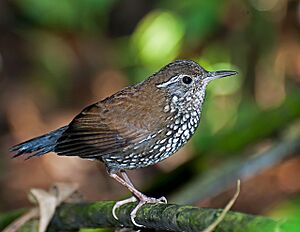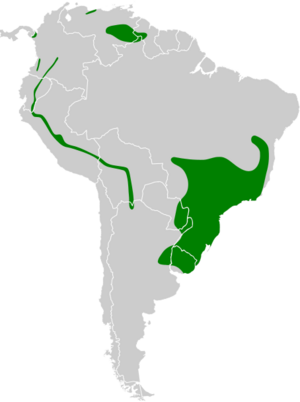Sharp-tailed streamcreeper facts for kids
Quick facts for kids Sharp-tailed streamcreeper |
|
|---|---|
 |
|
| In São Paulo, Brazil | |
| Conservation status | |
| Scientific classification | |
| Genus: |
Lochmias
|
| Species: |
nematura
|
| Subspecies | |
|
See text |
|
 |
|
The sharp-tailed streamcreeper (Lochmias nematura) is a small bird from South America. It belongs to the ovenbird family, which is known for building unique nests. This bird is also called the streamside Lochmias or simply streamcreeper. You can find it in Panama and most South American countries, but not in Chile, French Guiana, or Suriname.
Contents
About the Sharp-tailed Streamcreeper
Bird Families and Names
Scientists group living things into families. The sharp-tailed streamcreeper is the only bird in its special group, called a genus, named Lochmias. There are six slightly different types of this bird, which scientists call subspecies:
- L. n. nelsoni
- L. n. chimantae
- L. n. castanonotus
- L. n. sororius
- L. n. obscuratus
- L. n. nematura
Sometimes, scientists think one of these subspecies, L. n. obscuratus, might be its own separate species. But it's tricky because L. n. sororius has features that are in between obscuratus and the main type, L. n. nematura.
What Does It Look Like?
The sharp-tailed streamcreeper is about 13 to 14 cm (5.1 to 5.5 in) long. That's about the length of a smartphone! It weighs between 20 to 38 g (0.71 to 1.3 oz), which is lighter than a golf ball. Both male and female birds look the same.
This bird is mostly dark brown. It has a long beak that curves down a little. You might notice a thin white stripe above its eye. Its back is a rich reddish-brown, fading to a darker rump. Its tail feathers look a bit "spiny" because the tips are bare.
Its throat is whitish, and its chest is dark brown with many white spots. The belly is similar but has white streaks. The bird's eyes are dark brown. Its beak is black or brownish, and its legs and feet can be different shades, from pink to dark brown. Young birds look a lot like adults but have less clear spots on their undersides.
Different subspecies have small differences in their colors and patterns:
- L. n. obscuratus has less of a stripe above its eye and a duller brown back. Its throat and chest are darker with diamond-shaped spots.
- L. n. sororius has colors that are in between obscuratus and the main type.
- L. n. nelsoni has darker upper parts and more grayish undersides with fewer spots.
- L. n. chimantae is similar to the main type but has a darker, more brownish back.
- L. n. castanonotus has chestnut-brown upper parts and fewer spots and streaks on its undersides.
Where Does It Live?
The sharp-tailed streamcreeper lives in several areas that are far apart. Here's where you can find each subspecies:
- L. n. nelsoni: In the mountains of eastern Panama.
- L. n. chimantae: In the tepui region of Venezuela. Tepuis are flat-topped mountains.
- L. n. castanonotus: In southeastern Venezuela and nearby western Guyana.
- L. n. sororius: In the Venezuelan Coastal Range and through the Andes mountains in Colombia, Ecuador, and Peru.
- L. n. obscuratus: In the Andes from Peru, through Bolivia, and into northwestern Argentina.
- L. n. nematura: In Brazil, Paraguay, and Uruguay.
This bird was first seen in Guyana in 2002. It always lives near streams and small rivers where there are lots of plants. In the mountains, it lives in evergreen forests between 700 and 2,800 m (2,300 and 9,200 ft) high. In other areas, it lives in lowland forests.
Behavior and Life Cycle
Movement
The sharp-tailed streamcreeper stays in the same area all year round. It does not migrate.
What Does It Eat?
This bird eats many different kinds of insects and other small creatures, like spiders. It has also been seen eating tadpoles and even adult frogs! It usually looks for food alone or in pairs. It walks and hops on the ground, searching through fallen leaves and moss on rocks. It also looks in shallow streambeds, flipping leaves aside to find its prey.
Reproduction
Scientists are still learning about when the sharp-tailed streamcreeper breeds. In Venezuela, they nest during the wet season. In southeastern Brazil, they nest around September. These birds are thought to stay with one partner for life.
Their nest is like a ball made of roots and twigs, lined with leaves. They build this nest inside a chamber at the end of a tunnel, which they dig into an earthen bank. They usually lay two eggs. We don't know how long the eggs take to hatch or how long it takes for the young birds to leave the nest. We also don't know much about how the parents care for their chicks.
Vocalization
The sharp-tailed streamcreeper's song sounds pretty similar no matter where it lives. Its song is a series of dry notes that start slowly, get faster, and go higher in pitch. Then they stay on the same note before dropping down quickly. Its calls can sound like "sea-sick" or "tsiterit." When it's alarmed, it makes a "chet-chet-chet" sound.
Conservation Status
The IUCN (International Union for Conservation of Nature) has listed the sharp-tailed streamcreeper as a species of "Least Concern." This means it's not currently in danger of disappearing. It lives across a very large area, and there are at least 500,000 adult birds. However, the number of these birds is thought to be slowly going down. No immediate big threats have been found.
It's found in some protected areas. While it might be rare in some parts of the Andes, it's quite common in southern Bolivia and other southeastern regions.


